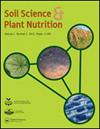盐碱地秸秆还田条件下土壤特性及水稻产量的变化
IF 1.8
4区 农林科学
Q3 ENVIRONMENTAL SCIENCES
引用次数: 2
摘要
种植水稻是有效利用盐碱地的一种方法,但由于盐碱地胁迫影响水稻生长,导致水稻产量不高。秸秆还田可以提高土壤肥力,但秸秆还田是否能改善盐碱地的理化性质,秸秆还田是否能提高盐碱地的生产力,目前尚不清楚。因此,我们在2017 - 2020年进行了为期4年的田间试验,评估了0、2800、4200、5600和7000 kg ha - 1 (CK、S1、S2、S3和S4)施用秸秆对盐碱地土壤物理性质、土壤化学性质、土壤养分和水稻产量的影响。结果表明,秸秆掺入后土壤容重(BD)和< 0.053 mm粒径团聚体百分比的降低与秸秆掺入率有关。秸秆处理土壤交换性Na+ (ENa+)和交换性钠百分比(ESP)显著低于对照处理,秸秆还田对降低土壤pH和EC也有积极作用。秸秆还田对土壤有机质(SOM)和全氮(TN)的积累有正向影响。随着秸秆掺入率的增加,土壤有机质和全氮逐渐升高。随着秸秆还田率的增加,水稻产量呈现先增后降的趋势,其中S3处理产量最高,4年平均产量为8.57 t ha - 1。试验期间,S3和S4处理在土壤物理结构、化学性质和养分方面均无显著差异。因此,我们得出结论,为了改善盐碱地性质和提高水稻产量,头4年合理的秸秆还田量为5600 kg ha - 1 (S3处理)。本文章由计算机程序翻译,如有差异,请以英文原文为准。
Changes in soil characteristics and rice yield under straw returning in saline sodic soils
ABSTRACT Planting rice is one method to effectively utilize saline sodic land, but the rice yield is not high due to the saline sodic stress that affects rice growth. Straw return can improve soil fertility, but it is unknown whether the physicochemical properties of saline sodic soil can be improved by straw return and whether straw return can improve the productivity of saline sodic land. Therefore, we conducted a 4-year field trial to assess the effects of adding straw at 0, 2800, 4200, 5600, and 7000 kg ha−1 (CK, S1, S2, S3, and S4) on the soil physical properties, soil chemical properties, soil nutrients, and rice yield in saline sodic lands from 2017 to 2020. Our results show that a decrease in soil bulk density (BD) and a decrease in the percentage of < 0.053 mm particle size aggregates after straw incorporation depend on the straw incorporation rate. Soil exchangeable Na+ (ENa+) and exchangeable sodium percentage (ESP) were significantly lower in the straw treatments than in the CK treatment, and straw incorporation also had a positive effect on the reduction of soil pH and EC. Straw incorporation had a positive effect on the accumulation of soil organic matter (SOM) and total nitrogen (TN). SOM and TN gradually increased with the increase of straw incorporation rate. Rice yield showed a trend of increasing and then decreasing with the increasing straw incorporation rate, with the highest yield under the S3 treatment at a four-year average yield of 8.57 t ha−1. There was no significant difference between the S3 and S4 treatments in soil physical structure, chemical properties, or nutrients during the experiment. Therefore, we conclude that a reasonable amount of straw incorporation for improving saline sodic soil properties as well as for increasing rice yield in the first four years is 5600 kg ha−1 (S3 treatment).
求助全文
通过发布文献求助,成功后即可免费获取论文全文。
去求助
来源期刊

Soil Science and Plant Nutrition
农林科学-农艺学
CiteScore
4.80
自引率
15.00%
发文量
56
审稿时长
18-36 weeks
期刊介绍:
Soil Science and Plant Nutrition is the official English journal of the Japanese Society of Soil Science and Plant Nutrition (JSSSPN), and publishes original research and reviews in soil physics, chemistry and mineralogy; soil biology; plant nutrition; soil genesis, classification and survey; soil fertility; fertilizers and soil amendments; environment; socio cultural soil science. The Journal publishes full length papers, short papers, and reviews.
 求助内容:
求助内容: 应助结果提醒方式:
应助结果提醒方式:


